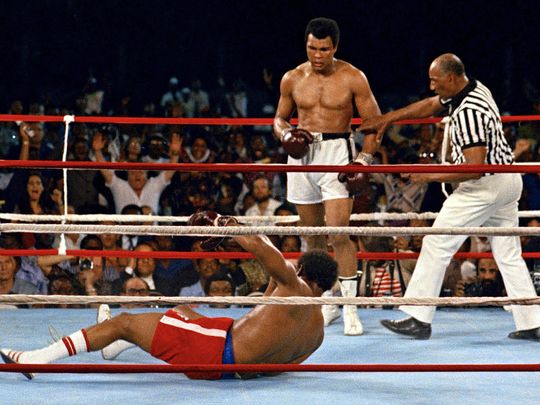Transformational Persuasion: Muhammad Ali, George Foreman, Donald Trump, Hillary Clinton, and Why It Matters – Especially When You’re Running an Arts Organization
Muhammad Ali died last week. A quote from a Zairian in “When We Were Kings.”
“George Foreman? We had heard he was a world champion.
We thought he was white, then we realized he was black, like Ali….
Ali said [about Foreman], you’re the out-of-towner here.”
Nonprofit leaders that manage organizations, programs, and people well can be quite successful. But not transformational. Transformational leaders effortlessly persuade with passion about the mission, not the statistics. Their material requires no script, just practice to remove the “ums” and “uhs.”
Trump, for example, vigorously (and effortlessly) transforms experienced opponents into “out-of-towners.” Clinton relies on effective policy, experience, and “being right.”
Passion KOs policy every time. Ask George Foreman.
Doesn’t your arts organization’s constituency deserve the most transformative experience you can offer? Or do you settle for production excellence and competence?
Special 2016 “Alan Harrison’s Birthday” Edition: Pack Up the Babies and Grab the Old Ladies – And an Easy-To-Fulfill Wish List

I was born on May 14. Conceived on a hot August night. Neil Diamond would’ve been proud. He was old enough to have a kid then, so…who knows? Brother Love? Are you my papa?
From him, I want flowers.
From you, I want (this is your cue):
- A 137-word card. ( <–Yes, that’s a link.)
- Share your favorite 137 Words post with your social network (that’s “share,” not “like”).
- To join a great company with a great mission. In Seattle.
- Health for The Kid.
- Guidance for The Kid.
- The love of my life to be happy, fulfilled, and curious. You know who you are.
- The ability for you to guide your favorite nonprofit to safety, security, and success.
- Brilliantly measurable missions, better than you believe you’re capable of.
- Complete, successful execution of those brilliant new missions.
- Pie, not cake.
Nonprofit Arts Executives: After the Ask (for anything, actually), It’s Fast “Yes,” Slow “No”… Try a Slow “Yes” Instead
If you don’t hear right away, it’s probably “no.”
That goes for asks, offers, hiring, and anything else you require.
And that goes for you, too, when your stakeholders ask, offer, hire, and anything else they may require.
Reflection is the predictable path toward rationalization to the “no.” This is why the phrase “upon reflection” is almost always followed by a version of “we’ve decided not to change.” After all, as a rule, it’s easier not to change than to take a risk.
Many arts charity executives preach the glory of “managed risk” (an oxymoron, of sorts) and value fiscal responsibility above social impact. To be clear, social impact is central to the success of the mission; fiscal responsibility is a valuable business practice.
If “yes” leads to greater impact, then stop saying “no”… especially upon reflection.
The Paradox of Simplicity: Success Begins with Better, Not More
There’s a saying that every weapon that’s been invented has been used. Or will be.
Similarly, every technological advance of the last 30 years has been used. Or will be.
More avenues of communication. More personalized offers. More database data. More news. More marketing. More music. More art. More words.
Not “better.” “More.”
This is not code for “I’m old and yearn for a simpler time.” I’m not and I don’t. What I yearn for is a better time.
Regardless of how many ways key information is dispersed, some folks just don’t consume it. And that’s on you.
I should know. You may be engaging with this post (and thank you), but others who could, don’t. And that’s on me.
A blown basketball pass is the passer’s fault. But a bad pass isn’t solved with throwing more basketballs.
Arts Organizations: 137th Post, 137 Thanks, and 137 (of Other People’s) Words That Guide Inspiring Leaders
“We must reject the idea — well-intentioned, but dead wrong – that the primary path to greatness in the social sectors is to become “more like a business.” Most businesses…fall somewhere between mediocre and good.” (Collins)
“If a man does not keep pace with his companions, perhaps it is because he hears a different drummer. Let him step to the music which he hears, however measured or far away.” (Thoreau)
“People don’t buy WHAT you do, they buy WHY you do it.” (Sinek)
“When they say things like, we’re going to do this by the book, you have to ask, what book? Because it would make a big difference if it was Dostoevsky or, you know, ‘Ivanhoe.'” (Anderson)
“‘To be is to do.’ (Socrates) ‘To do is to be.’ (Sartre) ‘Do be do be do.’ (Sinatra)” [Vonnegut compilation]
Nonprofit Arts Leaders: 137 Powerful Verbs for your Mission or Programs – Instead of Hyperbolic or Aspirational Adjectives. (Boring Headline, Yes?)

Accelerate
Achieve
Acquire
Advance
Advise
Advocate
Align
Amplify
Analyze
Arbitrate
Assemble
Assess
Attain
Audit
Award
Boost
Build
Calculate
Campaign
Capitalize
Chart
Clarify
Coach
Complete
Compose
Conserve
Consolidate
Consult
Convert
Convey
Convince
Coordinate
Correspond
Counsel
Create
Cultivate
Customize
Decrease
Deduct
Define
Delegate
Deliver
Demonstrate
Design
Develop
Devise
Diagnose
Discover
Document
Earn
Educate
Enable
Enforce
Engineer
Enhance
Ensure
Establish
Evaluate
Examine
Exceed
Execute
Explore
Facilitate
Forecast
Forge
Formulate
Foster
Further
Gain
Generate
Guide
Identify
Illustrate
Implement
Improve
Incorporate
Influence
Inform
Initiate
Inspect
Inspire
Integrate
Interpret
Introduce
Investigate
Launch
Lift
Lobby
Maximize
Measure
Mentor
Merge
Mobilize
Modify
Monitor
Motivate
Navigate
Negotiate
Orchestrate
Organize
Overhaul
Partner
Persuade
Pioneer
Plan
Produce
Program
Promote
Qualify
Quantify
Reconcile
Recruit
Reduce
Refine
Replace
Resolve
Revamp
Review
Scrutinize
Shape
Simplify
Stimulate
Strengthen
Succeed
Supervise
Surpass
Survey
Sustain
Target
Teach
Track
Train
Transform
Unite
Update
Verify
Yield
If You’re _____________, Then Your Nonprofit Arts Organization is Probably Unsustainable (with apologies to Jeff Foxworthy)
- not paying your executive director because s/he is independently wealthy and actually donates 6 figures to the company;
- working 70 hours/week every week and see nothing wrong with that;
- hiring part-time employees and expecting them to work full-time free of charge;
- of the belief that your employees are less important than your equipment or your building;
- insisting that anyone besides your marketing director is the final word on your marketing;
- keeping your artistic director away from donors because s/he doesn’t know how to interact with them;
- in the mindset that any of your people are more important than any other of your people;
- playing “Dialing for Dollars” to meet your payroll;
- arguing that “keeping the base” is more important than expanding the audience, while…
- thinking that you can do both;
- sweating a little right now after reading this post.
Organizational Health Can Be Measured by the Number of Donors Who Don’t Have to Give to Your Arts Organization
How many non-board (or non-ex-board) members give to your arts organization?
How many non-staff members?
How many non-parents (if you do activities that include children)?
How many people who don’t attend your gala or other special event?
How many people who refuse donor benefits?
In other words, how many people donate simply based on your mission, programming, and activities; or by trusting a stakeholder of your mission, programming, and activities without expectation of a return?
Count the households of donors who donated all on their own. If the number is small, create a special campaign to draw them in, even if the donation is a simple $50. And thank them – they’re giving for no reason at all, except for unconditional love.
Ultimately, the health of your organization is measured by the number of those who unconditionally support it.
Change Management and the Psychology of Surprise
I’m continually surprised by surprise announcements.
Seattle does not tolerate surprise announcements well. I’m not sure of a place where surprises go well, but in a city fomenting the crucible of passive-aggressive behavior (see this article for some fun), change without tortuous committee meetings is, well, gauche.
Recently, KUOW (Greater Seattle NPR news/talk licensed by the University of Washington) issued a surprising announcement that they’ve signed a deal to buy KPLU (Greater Seattle NPR news/jazz licensed by Pacific Lutheran University). Evidently, Pacific Lutheran University’s broke.
FYI: KUOW once purchased another non-commercial station, KXOT, to carry its KUOW2 programming. That failed.
Listeners/Members hate the idea and said so at a meeting on November 23. KPLU kept soliciting memberships even after the deal was signed.
KUOW comes off as untrustworthy, KPLU as desperate.
Surprise!
Stay tuned.
The Christmas Arts Season is Almost Here: Time for Much Mooing and Missions Drifting Higher than the Plowed Snow Blocking your Driveway
Once there was a theatre company that produced new plays. However, during the holiday season, they produced “A Christmas Carol.”
Foundation leaders that supported this company asked one day, “Why do you produce ‘A Christmas Carol’ when it has nothing to do with your mission or the rest of your activities?”
“Because,” said a truthful board president, “it’s our ‘cash cow.’ And we need to milk it for all its worth to pay for everything else we do.”
“Oh,” said the foundation leaders. “Does it?”
“Yes,” said the president. “It’s a good thing, too.”
The leaders huddled together.
“That’s wonderful,” they said. “It follows, then, that we can now fund companies whose mission aligns with ours. With your ‘cash cow,’ you don’t need us. Thank you!”
And then they cut funding to the theatre company to zero.
Differentiating Between What’s Great About the Arts and What’s Great About YOUR Arts Organization
You can look anywhere to discover what’s important about the arts. Try here, here, here, here, and here for starters.
The key to “sustainability” (which, as previously written, is not “survival”) is proof that your particular arts charity is achieving specific community goals.
Each social service and social justice charity measures its results toward the execution of their mission. Those results have a direct link to funding and community support. Your arts charity, then, must find results that apply specifically to your organization.
Charitable results cannot be measured by paid attendance or positive economic impact. Those are commercial results and byproducts — data used by sports teams to get cities to build them stadiums or by entertainment conglomerates to allow regions to let them build casinos.
So what makes your arts charity charitable? Answer that and you’re 99% there.
The Psychology of Being Last and 4 Other Ways to Level the Board Meeting Room Table
 Board meetings are often reporting festivals. Endless polite reports reminiscent of “what I did last summer” essays from the first day of elementary school. It’s too bad.
Board meetings are often reporting festivals. Endless polite reports reminiscent of “what I did last summer” essays from the first day of elementary school. It’s too bad.
Calculate the hourly consulting rate of the people in the room (for example, 15 board members x $100/hour = $1,500/hour). At $1,500/hour, do you want to talk about the past or the future?
Board members, inside the meeting room…
- Never do what the last person in the conversation advocates. It’s a trick manipulative people do.
- Consensus is not unanimity; votes needn’t be unanimous. After the decision is made, however, everyone needs to back it.
- No devil’s advocates; take responsibility for your disagreement.
- Read the ED’s report beforehand. EDs: issue your report at least a week before the meeting.
- Your ED is not responsible for writing and executing your strategic plan. You are.
“In This Scene, Could You Be a Little Funnier?” – A Perspective on Performance Reviews
“Fire ’em the first time you think about it.” This was the mantra of the board chair of a company with which I was affiliated. I’ve always appreciated the portion that means that I should know when things are not working with a company or individual – from the perspective of employer or employee.
Which brings me to performance reviews. Gack. Many formal performance reviews within arts organizations waste time and energy and breed unnecessary anxiety. That’s not to say that you shouldn’t do them – but do them continually rather than once a year or when a contract demands it.
If your company has a horrible work environment, a performance review is about as helpful as a Band-Aid on a heart attack. Similarly, if the environment is open-minded, so should your inter-reactions. You’ll know if it’s working out.
Quantifiable Outcomes and Social Impact Applies to All Nonprofits – Including Arts Organizations
Oh, I can hear it now.
“See?” they’ll say. “People don’t care about outcomes when they make donations. The Washington Post said so. Ergo: we don’t need outcomes.”
To come to that conclusion is just whistling past the graveyard.
Remember these hard facts:
- The arts are not mentioned in section 501 (c) (3) of the US tax code (you know…the law). The arts fall under “charitable organizations,” which require a measure of public good.
- Using the arts as a cover for an individual’s vanity vision is fine, as long as it’s a commercial venture. Once you pull the taxpaying public into it, ethics demand an outcome.
- The arts can be transformative, both on a commercial and nonprofit level. What differentiates the nonprofit is that a measurement of positive change of the human condition is necessary to rationalize funding.
Just Because Someone Repeats It Doesn’t Make It True: Nonprofit Arts Organizations Must Serve a Charitable Purpose or Die Trying
Supposedly, Martin Van Buren wrote to Andrew Jackson imploring Jackson not to approve the railroads for fear of the loss of the canal system, citing mass unemployment, the closing of boating businesses, and the fear of trains moving at breakneck speeds of 15 mph. It never happened. I checked.
In W. P. Kinsella’s Shoeless Joe, “If you build it, they will come” was actually “If you build it, he will come” and referred to the farmer’s father. Not “If you build an arts center, thousands of new patrons will come, regardless of programming.” Read the book.
There is another fabrication that arts organizations are nonprofits simply by being arts organizations. It’s not true. I checked.
All over the US, there are myriad arts nonprofits that don’t serve a charitable purpose. Rightfully, foundations are noticing and diverting funds elsewhere.
There’s Not An App for That
There are an endless number of costly, effective CRM systems for the arts. One costs hundreds of thousands of dollars and it’s superb at what it does.
One might say, “It had better be.”
Before that expensive, expansive piece of software, there were others. Some great at some things, some at others.
Not one of these pieces of software ever raised a dime. People do that.
Not one of these pieces of software ever performed, exhibited, or created a compelling artistic experience. People do that.
Not one of these pieces of software ever governed, advocated, cajoled, or counseled. People do that.
Before CRMs that cost various ulnae, fibulae, and tibiae, there were inexpensive off-the-shelf database software solutions.
Before that, we did it all on paper.
Millions attended. Millions still do.
And the best relationships are still person-to-person.
Rancho Santa Fe Dinosaurs and Behemoth Nonprofit Arts Organizations

Washington Post reported that some uber-wealthy Rancho Santa Fe, California dinosaurs refuse to conserve water in the worst drought in California history. Consumption there is up 9% (the only area in California increasing consumption), because, as one resident put it: “We should not be forced to live on property with brown lawns, golf on brown courses or apologize for wanting our gardens to be beautiful.”
Why? See below for the answer to “Why do dogs lick their genitalia?”
The nonprofit arts industry deserves support. No question. “Arts and culture policies and programs increase economic development in states by attracting businesses, creating new jobs, increasing tax revenues and promoting tourism.” National Conference of State Legislatures
But when “Indominus rex” institutions drink up inordinate percentages of funding (larger than their share of the market), is it just…
“because they can?”
Ethics: “You can’t just ask people to behave ethically just like that.” -Sepp Blatter, Friday, May 29, 2015
 One foundation makes a grant for a pet project and then gets other foundations to commit money to that same project. And then decreases its gift by the amount the other foundations contribute.
One foundation makes a grant for a pet project and then gets other foundations to commit money to that same project. And then decreases its gift by the amount the other foundations contribute.
One nonprofit arts organization that sent its executive on an expenses-paid vacation to Europe, paying for it with tax-deductible donations.
One executive director that increased the YOY marketing budget of the organization by 50% based not on history or data, but on “that’s how much we’re spending, so that’s how much we have to make.”
One board of directors that undertakes an emergency “going-out-of-business” desperation fundraising campaign, but after raising the money, changes nothing about the way it does business. And then does it again.
Hundreds of nonprofits having to deal with trust issues from nervous donors because of unethical behavior from a disgusting few.
If Educational Attainment is the Most Valuable Predictor of Arts Attendance, Can the Arts Become a Magnet for a More Highly-Educated Populace?
39.4% of Americans have at least a 2-year college degree.
Of the 25 most populous metropolitan areas (not limited to the city limits), only 15 surpass that percentage by more than 1%.
They are (in order of percentage, high-low):
- DC
- Boston
- Oakland-San Francisco
- Minneapolis
- Seattle
- Denver
- New York
- Baltimore
- Pittsburgh
- San Diego
- Portland
- Chicago
- Atlanta
- Philadelphia
- St. Louis
Coincidentally, every one of these cities exceeds the mean in inter-city US migration (moving from one US city to another).
When you eliminate people who have attended school-based arts performances and exhibitions in which they have a significantly personal connection to the art (a child, a neighbor, etc.), fewer than 50% of Americans have paid to experience the arts.
Does that mean that we give up on the arts in other metropolitan areas? Or might the arts serve as an attractor for highly-educated migrants?
Marketing Arts Charities: In 2014, It’s about Me (Not You… Me)
Attracting Millennials to the arts isn’t the easiest thing in the world. What worked with the Greatest Generation hasn’t worked with Boomers or Millennials.
This summer, Coca-Cola put names on the bottles (common first names for those born in the 80s and 90s). Then, a Coke turned into something about “me.”
Look what I’m drinking… it’s me!
We’ve also seen hundreds of bucket challenges to support ALS research, which is great. The product sold in the videos is “me.”
Look what I’m using to do good in the world… it’s me!
Marketing the transformative experience of the arts works best when it’s about “me.”
Look at that amazing artwork/ballet/opera/play/musical… it’s me!
If you can make the experience about the patron (not for the patron), you’ll have a fan for life.
Or at least until the next big thing.
Careers in the Arts: It’s Pretty Ugly Out There
Paul Begala said, “Politics is show business for ugly people.”
The converse, that show business is politics for pretty people, is equally true.
Pretty (young) people enter nonprofit arts leadership believing that they should land a high-paying managing director’s job within 3 years. Ginormous student debt is predicated on that prospect.
Ugly (old) people, therefore, had better vamoose, and decrease the surplus population, to paraphrase C-Dick.
Pretty people panic at red ink. They leave. No experience or belief in failure.
Ugly people see an opportunity. They know when to duck and when to charge.
Consider for your next important hire:
- When hiring for “fit,” by definition, you’re hiring to appease. Don’t expect much change.
- When hiring for “innovation,” you’re hiring to anticipate obstacles. And only someone who has experienced obstacles (and carried on) knows how to do that.
Arts Charity Strategy: When Substitutes and Competitors Blur, Does Your Organization Become Unfocused?
In 1979, Porter’s Five Forces Analysis tool was published by the Harvard Business Review. If you haven’t studied it, do so. But study it hard – it’s far more comprehensive and complex than “5 Tips to Get More Donors” or others in the current mini-list nonsense arena.
When arts charities view competitors (those that do what we do) and substitutes (those that do something that the customer will do instead of what we do) as one force, they lose mission focus, and once that happens, they begin the downward spiral.
To wit: if you run a theatre, your competition is “theatres.” If you make the mistake of thinking that “video games” is a competitor (rather than a substitute), the logical conclusion is that you need to provide “television” instead of “theatre.”
Be a theatre. That’s hard enough these days.
Labor Day: “I Hear America Singing,” by Walt Whitman, 1867 (153 words. Yeah, I know.)
“I hear America singing, the varied carols I hear,
Those of mechanics, each one singing his as it should be blithe and strong,
The carpenter singing his as he measures his plank or beam,
The mason singing his as he makes ready for work, or leaves off work,
The boatman singing what belongs to him in his boat, the deckhand singing on the steamboat deck,
The shoemaker singing as he sits on his bench, the hatter singing as he stands,
The wood-cutter’s song, the ploughboy’s on his way in the morning, or at noon intermission or at sundown,
The delicious singing of the mother, or of the young wife at work, or of the girl sewing or washing,
Each singing what belongs to him or her and to none else,
The day what belongs to the day—at night the party of young fellows, robust, friendly,
Singing with open mouths their strong melodious songs.”
The Politics of Charity: Minding Your Speaking Your Mind
Some of us are more candid than we probably ought to be. We put ourselves out there. But remember this as you read this blog and other business columns: things change.
Each charity has a special mission (or at least should) that may relate to other charities in the universe, but not exactly. There is no right or wrong way to do it. And expressing a thought in a column – such as 137 Words – does not equate to either a Sermon on the Mount or a whisper from Jiminy Cricket about that charity. It is merely an expression based on the writer’s own vantage point.
So when Covey, Collins, Porter, or even Harrison proclaim a truth, it’s not backpedaling to say that the “truth” is a reaction to what’s happening right now. And that things change.
More on Charities and Families: Find a Way to Answer “NO” to Form 990, Part VI, Line 2
“XYX YXYXYXYX (WHO SERVES AS GENERAL DIRECTOR AND ARTISTIC DIRECTOR, CEO) AND XXX XXXXXXXX (WHO SERVES AS EXECUTIVE DIRECTOR – DEVELOPMENT AND MARKETING) HAVE A FAMILY RELATIONSHIP”
Their two combined salaries (excluding payroll taxes) to total budget: 6.0%.
Their two salaries to all salaries: 12.7%
These two employees to all 406 employees: 0.5%
Ratio, these two employees’ salaries to all employees’ salaries: 25-1
Current year surplus/(deficit): ($3,239,641)
Are your decision-makers married or in some family relationship? For a for-profit company, that’s fine. Family businesses and for-profit nepotism are mostly fine.
But charities, owned by the community and answerable to its constituents, are not family businesses. And when they act irresponsibly, like the above arts organization, it’s a travesty that negatively affects the whole industry.
Because now we have to convince supporters that this won’t happen to their donation.
Arrogance, thy name is YXYXYXYX.



















